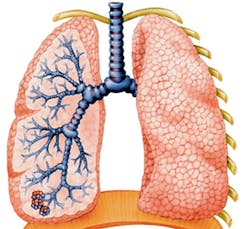CT scan technique differentiates types of lung damage
A team from the University of Michigan Medical School (Ann Arbor, MI, USA) has used a technique called parametric response mapping (PRM) to analyze CT scans of the lungs of patients with chronic obstructive pulmonary disease (COPD).
They say that the PRM technique allows them to better distinguish between early-stage damage to the small airways of the lungs, and more severe damage known as emphysema. They have also shown that the overall severity of a patient's disease, as measured with PRM, matches closely with the patient’s performance on standard lung tests based on breathing ability.
"Essentially, with the PRM technique, we’ve been able to tell sub-types of COPD apart, distinguishing functional small airway disease or fSAD from emphysema and normal lung function," says University of Michigan professor Dr. Brian Ross.
COPD limits a patient's breathing ability, causing shortness of breath, coughing, wheezing and reduced ability to exercise, walk and do other things. Over time, many COPD patients become disabled as their disease worsens.
"In the last decade, CT scan techniques for imaging COPD have improved steadily, but PRM gives us a robust way to see small airway disease and personalize treatment," says Dr. Ella Kazerooni, a radiology professor who leads U-M's lung imaging program.
Originally developed to show the response of brain tumors to treatment, the PRM technique allows researchers to identify COPD specific changes in three-dimensional lung regions over time.
Already, a U-M spinoff company, Imbio, has licensed U-M's patents on the PRM technique, and is developing the technology for use in early prediction of treatment response of brain tumors and other cancers. Now Imbio has begun developing PRM for COPD subtype diagnosis and tracking.
Recent articles on CT scanners that you might also be interested in.
1. CT scan helps with digital dissection of prehistoric mite
Researchers at the University of Manchester and Humboldt University, Berlin have produced 3-D images of a prehistoric mite as it hitched a ride on the back of a 50 million-year-old spider.
2. CT skull scanning reveals eating habits of dinosaurs
A team of international researchers led by Bristol University (Bristol, UK) and the Natural History Museum (London, UK) has used CT scans and finite element analysis to show that Diplodocus -- one of the largest dinosaurs ever discovered -- had a skull adapted to strip leaves from tree branches.
Vision Systems Design magazine and e-newsletter subscriptions are free to qualified professionals. To subscribe, please complete the form here.
-- Dave Wilson, Senior Editor, Vision Systems Design
